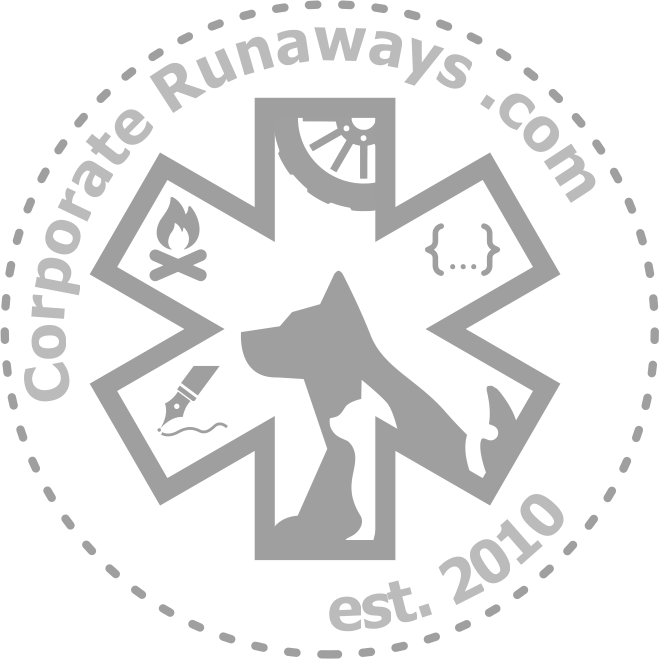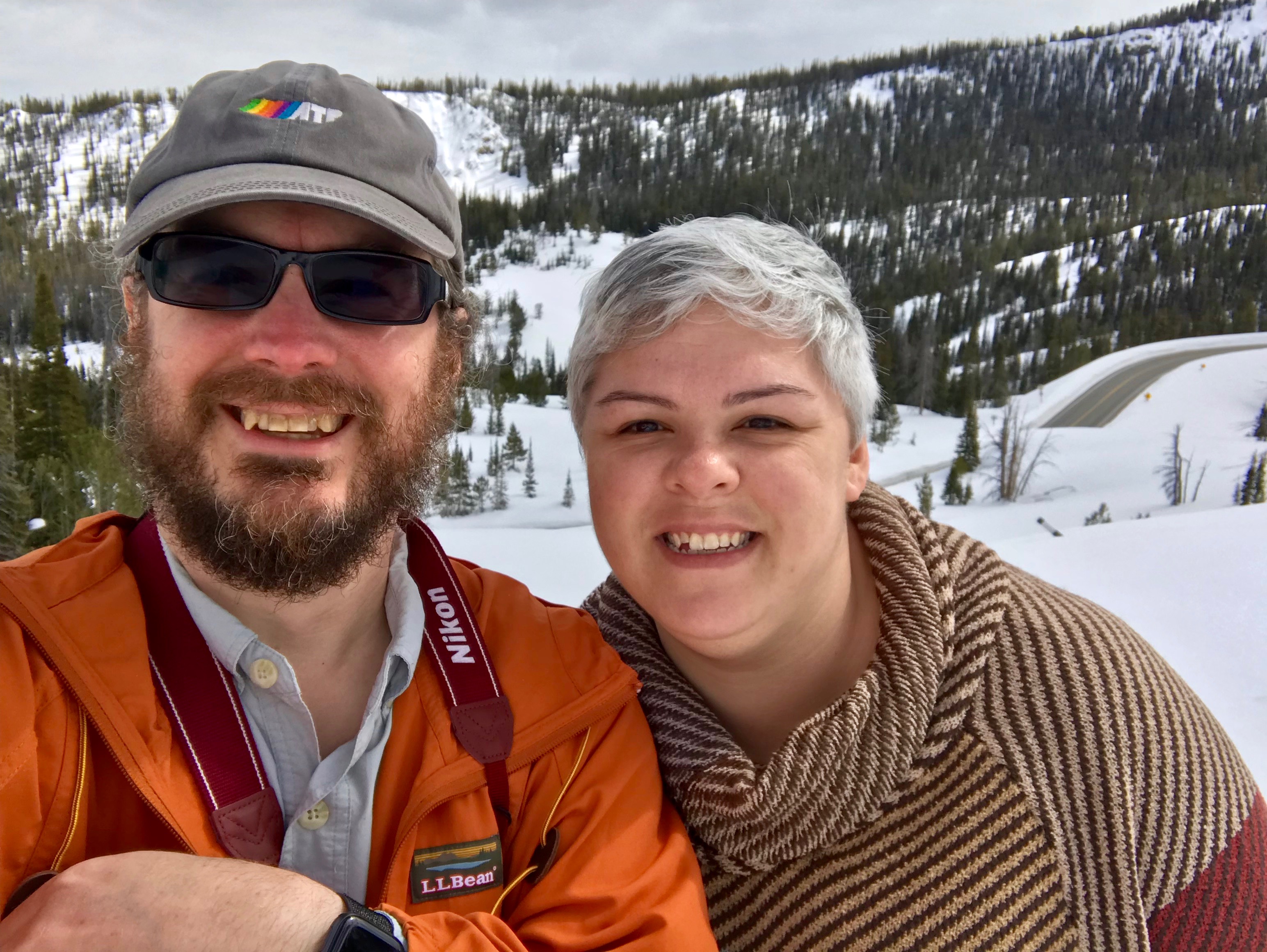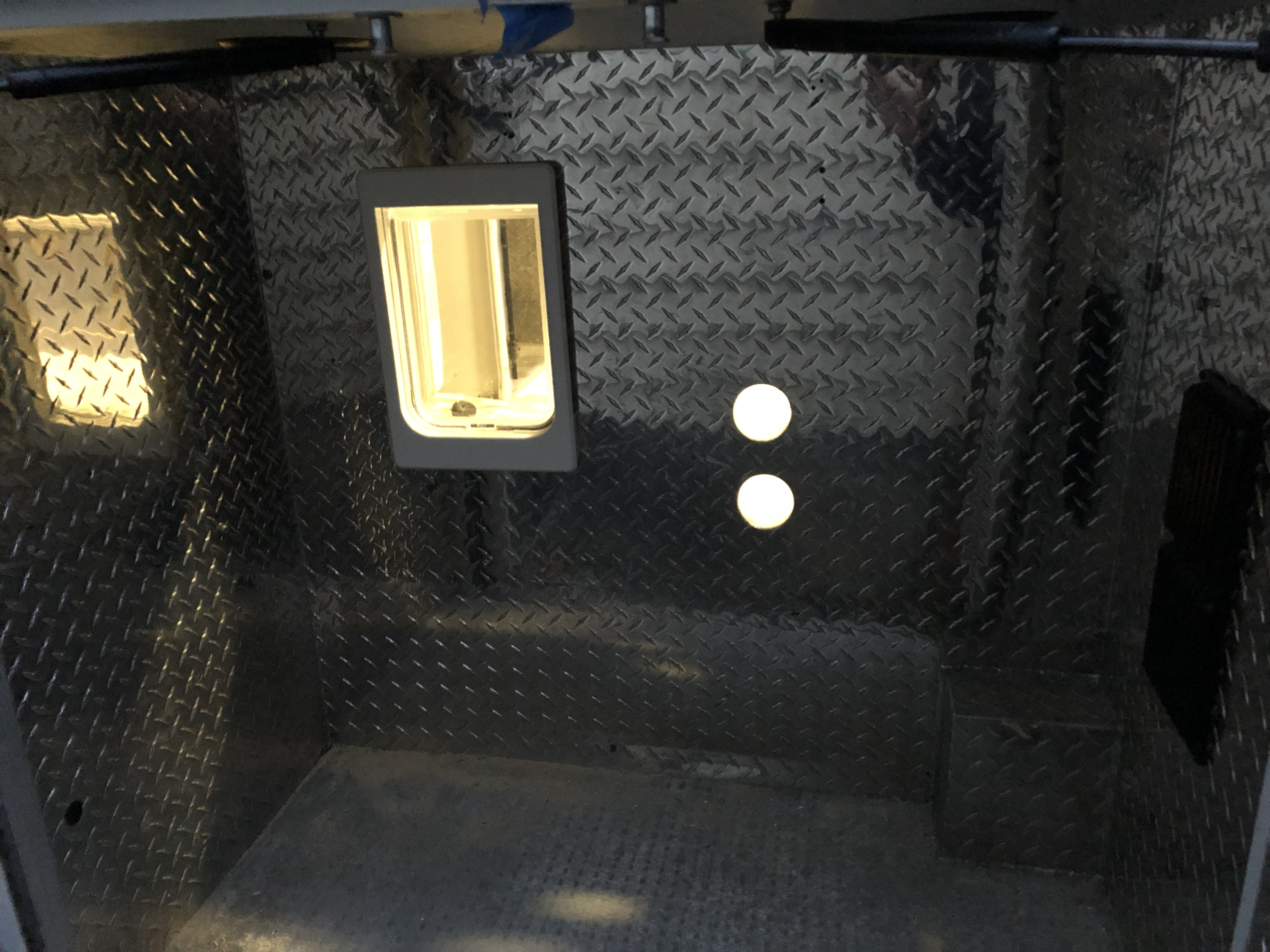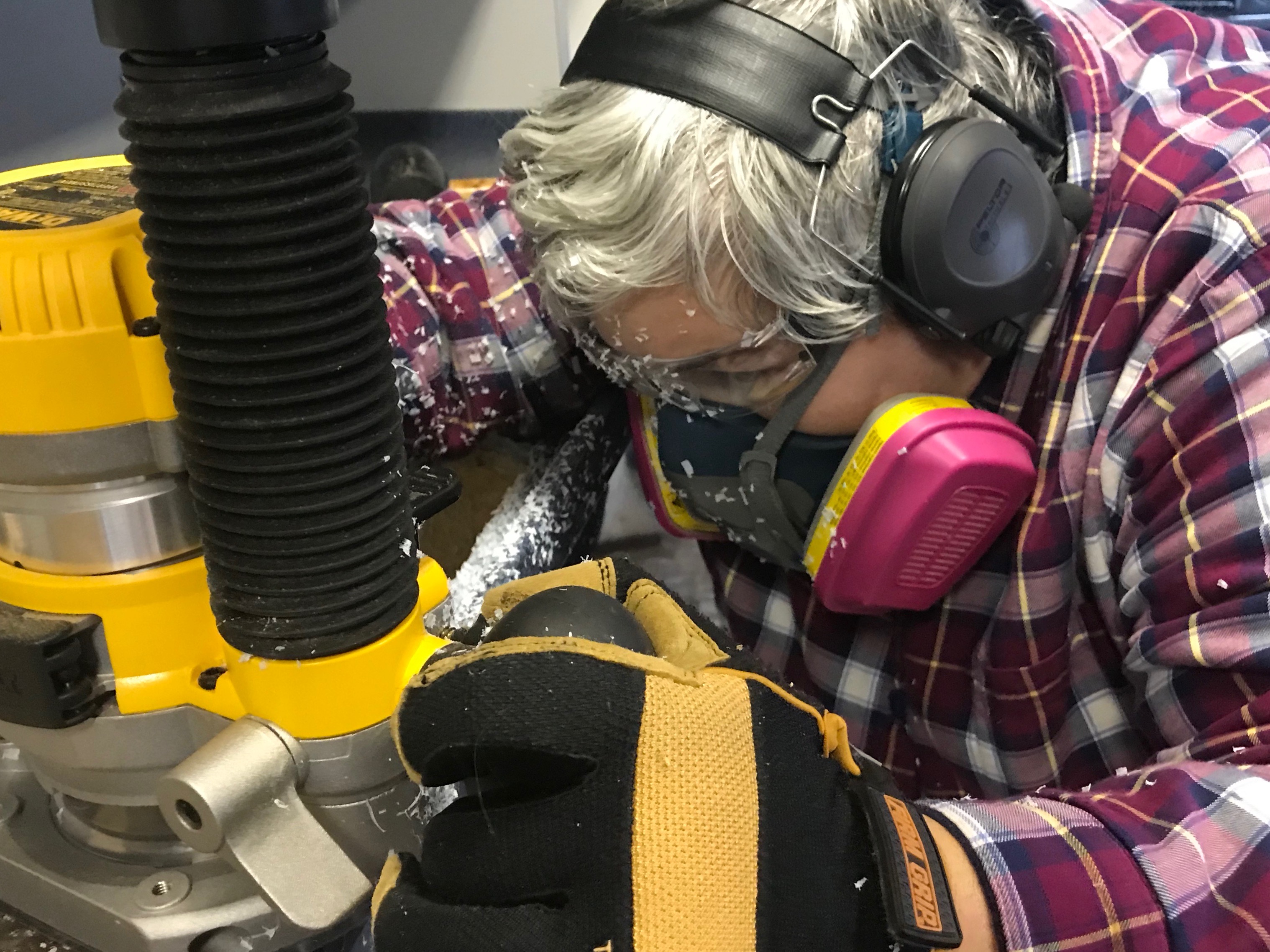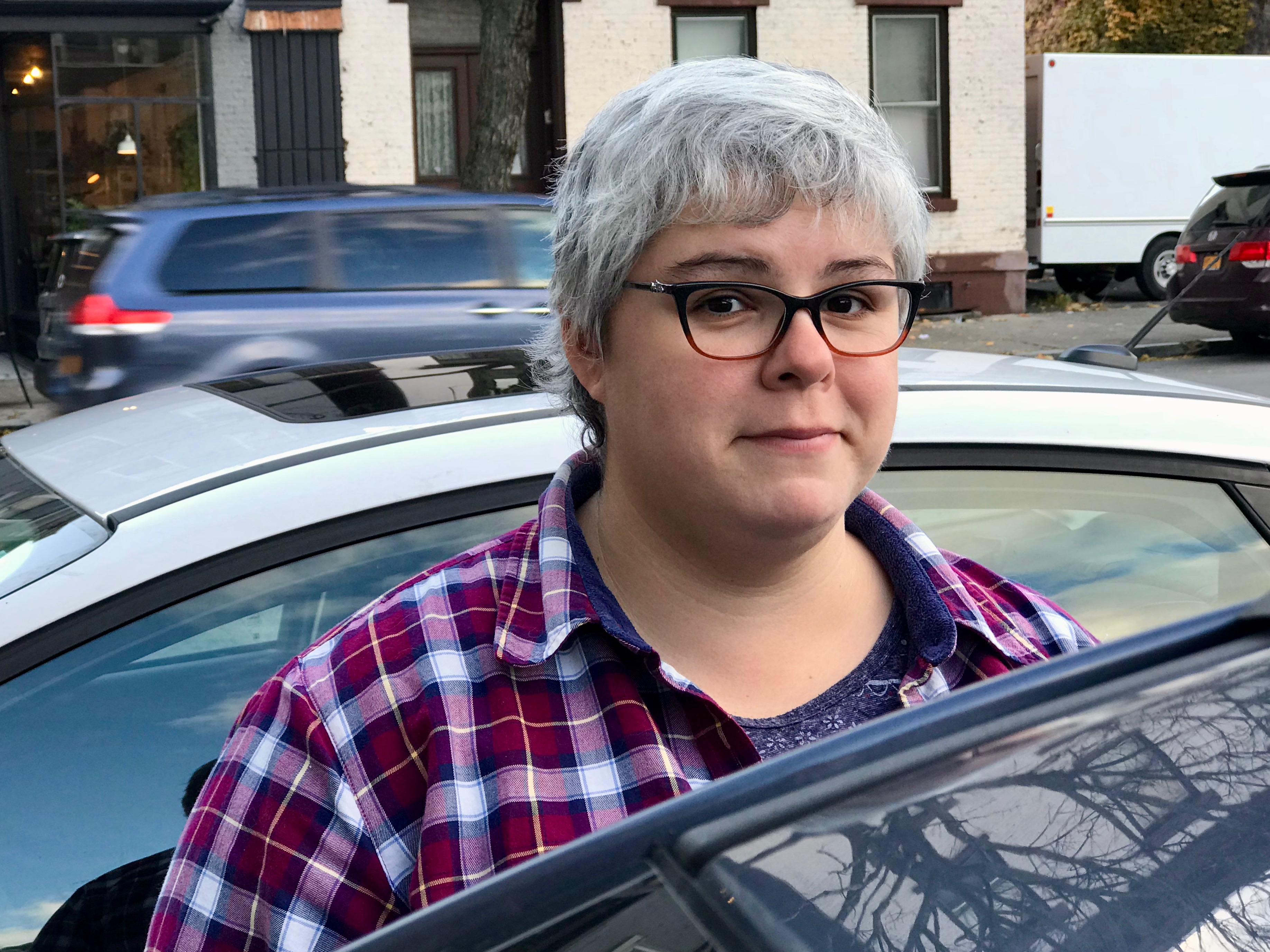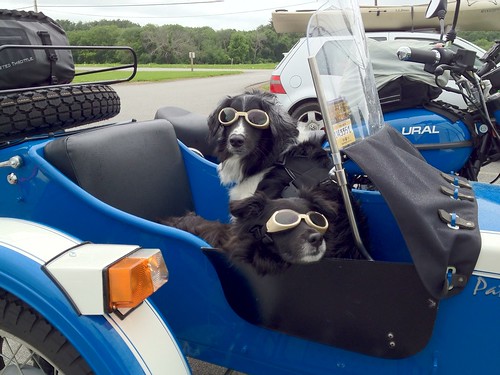
Part of this journey was to test how they felt about spending day after day in the sidecar, and how they handled hot weather in it. Because of the miles we had to cover, this ended up being an even bigger test of that. When left to our own devices we’ll spend about eight hours a day “on the road”. That includes all the breaks for breakfast lunch, fuel, bathrooms, and simply stretching the legs. Those breaks just get a bit longer with the dogs.
On this trip we had a number of 10-12 hour days, which isn’t something we enjoy, and wouldn’t normally ask them to deal with. Despite that, they still bounced and barked with excitement every morning when we pulled out their harnesses, climbed in before we were done packing up and ready for them, and climbed back in every time we asked them to, except for two times on crazy hot days, which I can’t blame them for.
But, they got more about six walks a day, instead of the normal three, although some of them were short), and lots of tasty food, and extra exercise in the mornings and after the day’s ride.
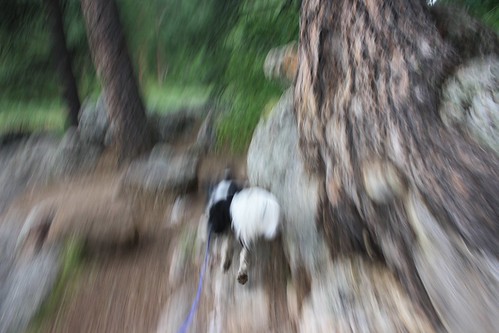
Riding with them
I don’t know what I was expecting. Surely, it complicates matters in ways I’d expected to be somewhat annoying, but in practice I just don’t care. Yes, we have to carry more stuff and spend more time and stops, but we’re ok with that. I worry about them on hot days, but that’s ok too. I don’t mind worrying about my family being safe. On those “hair-dryer days” we take a little time at the frequent gas stops to see if they’re keeping cool. I water them so that they can pant, I rub them down to simulate sweat. I take care of them, and when I’m done I feel good.
Taking care of them was pretty easy:
- Give them water every two tanks ( or every tank on crazy hot days ).
- Put the Frogg Toggs Chilly Pad under them when it’s hot out. That thing worked surprisingly well. On a couple of the 100°+ days we got them out for a walk and whatever piece of them had been sitting on the pad was nice and cool, and not just the outer fur.
- Walk them whenever we stop for a snack, or a meal.
- If you’re dealing with 100°+ days, do your best to get as much of your riding in in the wee morning hours as possible. It’s better for them and you. Then get into some AC in the afternoon if at all possible.
Comfort

The standard seat would simply not be comfortable for even one decently sized dog for even a couple hours. We had a custom seat cushion made for them that runs the length of the sidecar. I would have made something similar if there wasn’t already someone with experience making them, who would make us one. Major thanks to Riddle’s Custom Upholstery. The cushion held up great and its guts stayed dry even when we it got rained on by the seams and was sitting in a quarter inch of water for fifteen minutes. That was the day we tested what happens with one side-open in a downpour. ;)
As you can see in the picture above, there’s plenty of space. Dido spent about half of his time in the nose, and half of it with his head out the side. Ben would perk up when we went slow, or when we were stopped, but rested the majority of the time.
The sidecar cover (more details below) provided them with a good amount of shade, and on the hot days when we had to reach in and unclip them we’d frequently lean our heads in to see what the climate was like in there. It was always notably cooler in their shade.
All-in-all, they had a far more comfortable ride than we did. I am definitely envious.
Care and Feeding
At the start of the trip the dogs were almost totally uninterested in their kibble, so we compensated by giving them human food, which they never hesitate to eat. By about ten days in they were starting to eat more and more of the kibble. We watched what came out of them carefully to make sure their systems were happy. I suspect that on a longer trip they’d be eating much more kibble at the end of each day, but that’s a double-edged sword. It’s not always easy to find, and it takes up a lot of space.
With regards to the human food vs. dog food debate. Dachary’s done a lot of research on it and it turns out that there are a number of human food diets that you can feed dogs that will keep them healthy. But the big problems with human food are: human food contains a lot more calories, so you need to watch the dogs closely to ensure they’re not getting fat. And human food may not contain all of the nutrients that dogs should be getting. So, as long as you’re feeding them a balanced diet and watching them to make sure they’re not getting too many calories, a fully human food diet is perfectly safe for dogs. The catch, of course is knowing what a “balanced diet” is for a dog. Dachary’s got a pretty good idea at this point, and for the RTW we’ll probably bring some doggie supplements, and continue giving them a mix of human food and kibble.
Keeping them hydrated would have been tricky if not for Bandido. His street-smarts made him drink whenever he needed it, in plentiful quantities. Ben, on the other hand, would only drink if Dachary was present (sometimes both of us) and he wasn’t being overly distracted. We used Bandido as a barometer. If he wasn’t drinking then we didn’t need to worry about getting more into Ben.
Shade was a constant concern. It’s amazing just how many gas stations and restaurants in the USA, and Canada have gone to great lengths to remove every possible source of shade from their lots. They’d probably save a lot on their air conditioning bills if they’d just plant some trees. The sidecar cover worked great at providing shade while we rode and keeping them far more comfortable during the ride than we were, but parking at the right angle to block the sun completely isn’t always possible, and the sun can move quite a bit during a half-hour stop.
Routine
Routine is important to a dog, and being on the road every day is not in most dog’s routines, but that’s not to say that it can’t be. We took care to gradually acclimatize them to riding in the sidecar before the trip, and both of them came to regard the sidecar and the tent as “home”. Ben’s a bit of an introvert, and when stressed out by too many people, or simply looking for somewhere comfortable and shaded to hang out he’d climb back into the sidecar.
Most days on the road we’d do essentially the same thing. Go for a walk, pack up the tent / room. Get in the sidecar. Go find breakfast. If it was a take-out kind of place (or gas station food) we’d bring it out, leash them to the sidecar and sit on the ground eating with them. They always got a portion too. Back on the road we’d stop to water them and let them pee every two tanks of gas (which wasn’t particularly long with the Ural). On hot days we’d water them every time and rub them down if needed. Around lunch time we’d stop and eat. Again, if it was take out kind of food we’d usually eat with them, and again, we’d get them a portion, and they’d always get a walk at lunch. Back on the road we’d repeat the same two tank routine until we reached our destination.
Being a more intelligent, and thus a bit more neurotic, dog it took about ten days for him to really start settling in to the routine. Bandido, being a street dog, started settling in to the changes almost immediately. But, we found that the best way to gauge how well they were acclimatizing was by watching how much kibble they ate at night. They’d ignore it in the mornings, but each night, they’d eat a little bit more than the previous night. By the end of the trip they were starting to eat pretty standard evening amounts.
Sleeping Arrangements
We got a child-sized sleeping bag, plus a pretty heavy-duty inflatable mat for it. Yes, they could sleep on the ground, but they can’t dig the soil through the tent to soften it up for themselves (‘Dido does this constantly when he wants to rest outside). So, they need something soft to lay on, especially considering they’ll be doing this most nights… or they will on the RTW trip… assuming Kansas doesn’t follow us. Also, there will be nights around freezing so we need something to cover them with and keep them warm. The inflatable mattress plays a part here too because the ground will suck a lot of heat out of you on cold nights. Insulation is a big part of the motivation to use a sleeping mat - not just comfort - so we want to make sure the dogs are insulated from the ground on cold nights when they need it.
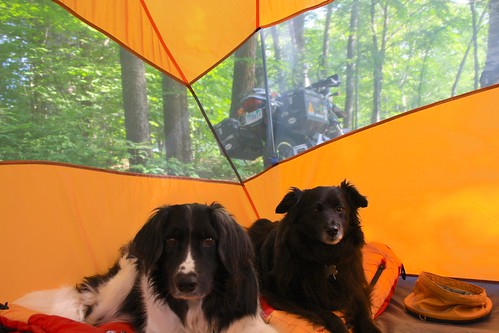
We figured both dogs could fit on it, and keep each other warm on cold nights. In practice they could both fit, but they’d have to sleep against each other and they don’t do that unless they have to. When Ben stretches out on warmer nights he easily covers the length of it. Curled up, they can both fit with a little room to spare.
In reality, one dog almost always ended up sleeping on our feet on the sleeping bag and the other would sleep on the dog bed. This, of course, made it difficult for us to have sufficient room, but it happens at home, too, so we’re used to it. Bandido would sometimes lay on the ground just because it was cooler. In Colorado, when it was cold, we tried covering a dog with the dog sleeping bag and covering the other dog with our motorcycle jackets to keep them warm. In the morning, both dogs were still covered - they hadn’t kicked off the blanket/jacket so clearly they wanted the warmth. Kay would check them periodically through the night to make sure they weren’t shivering and didn’t need more covering and never noticed a problem. This winter we’ll figure out how they handle sleeping in the cold.
Lessons learned
Dogs need bigger towels than people. We figured they were less than a quarter of our size, so small towels would be fine. Ben had a towel the same size as Kay’s and Bandido’s was even smaller. This was absolutely a mistake. We use chamois-style pack towels because they fold up very small, but for the next trip we will be buying the largest size on offer for each of the dogs… and a spare. Their fur just holds too much water.
Having a large vestibule on your tent is really useful for drying off the dogs before they come inside. Every dog owner knows you’ll never get them completely dry, but getting off the moisture there was definitely good.
We use sleeping bags with inflatable mats under them (highly recommended). Do not attempt to inflate your mat and set up your sleeping bag with dogs in the tent. They would constantly lay on it in the middle of setting it up. You’d make them move, and they’d go lay on something you were about to need to muck with. Then they’d go back on your sleeping bag, or mat… ugh. Pain in the butt. We took to just clipping them to the Ural while we set up the tent’s contents.
Neurotic dogs may thoroughly enjoy riding in a sidecar, but you’ll probably have a harder time getting them to eat and drink enough. Trying to find somewhere to park with minimal foot-traffic is probably your best bet, but it’s not always possible.
The water bowl proved more problematic than anticipated in the tent. Fortunately we learned this on the pre trip camping weekends. `Dido noses the food bowl around in an attempt to bury it, and frequently hits the water bowl. Tents don’t offer a lot of moving room so it’s not uncommon to accidentally knock something into it. Also, dogs aren’t great about keeping water in their mouths. Combine all these and you’ve got a wet floor. We upgraded our water bowl to the Ruff Wear Bivy Pet Bowl and this made a big difference. The sides angle in towards the top which helps keep the water in even when it gets bumped. We also got better about how we organized the tent’s contents, and where we placed the water bowl relative to them.
There’s not much you can do about the drips from their mouths after they drink, so we just kept the bowl as far from the sleeping bags as possible, because you really don’t want wet down.
The Sidecar Cover
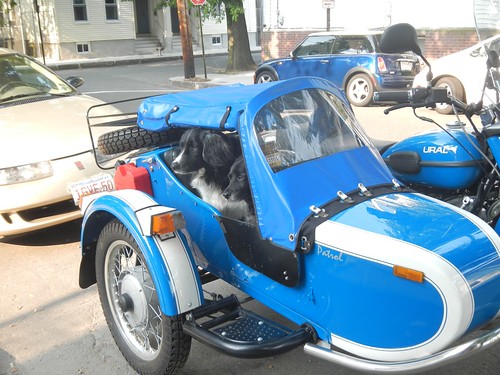
I believe that having a good sidecar cover is essential to long trips with the dogs. Overall I think ours was just about perfect. I’ve got another post coming up detailing what worked and what didn’t about it, but for the purposes of this dog-centric post the most important things are that your cover provides shade during the day, keeps them dry even in the worst unexpected rains, and provides a lot of ventilation. The opaque cover across the top with roll-up sides proved to be an excellent design idea.
We’d sometimes roll one side down to halve the amount of air blowing in on them, and if we rolled down the outside side it would dramatically decrease the possibility of someone reaching in from the tub side and attempting to pet them. In lighter rains we could ride with just the outside side down and they’d only get a few drips on them.
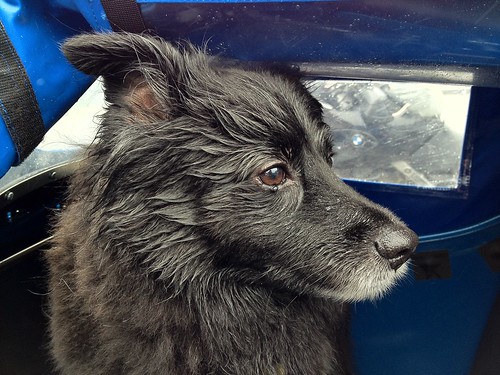
Given the opportunity, though `Dido will stick his head out no-matter the weather. One half of his face is soaked. The other is dry. Ben, kept his head in during this particular rain, and stayed nice and dry as a result.
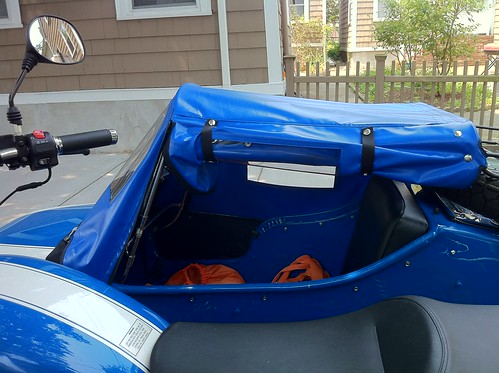
When we stop and go in to a restaurant, it’s not uncommon for us to leave the outside side down to discourage all but the crazy people from attempting to pet them, because with the inside side open you’d have to lean in over the bike to get to them.
Kit
Our Favorites
- Frogg Toggs Chilly Pad
- Ruff Wear Bivy Pet Bowl This made a great water bowl because in addition to collapsing well, the sides hold themselves up and angle inwards, which made it more difficult for the dogs to tip it over in the tent. I think it’s a bit too small to use as a food bowl for a dog with a medium sized muzzle like Ben’s. The dogs were constantly tipping over our old water bowl, which is a giant PITA in a tent, so we found this to be a far superior option.
- Outward Hound Deluxe Bottle ‘N Bowl Bag This thing is spectacular, but we actually made one enhancement along the way. On a day where we’d misplaced the bowl I cut the bottom off of a 32oz. plastic cup to use as a water bowl. It fit perfectly under the water bottle we use in it, and from then on we just kept using it instead of the collapsable cloth bowl. We kept it in the nose of the sidecar, and we’d use this bottle and bowl to give the dogs water when we stopped at the gas station. When the water bottle was emptied, we’d refill it from the Camelbak Unbottle that the dogs inherited (which also lived in the nose of the sidecar). The Ruff Wear Bivy Pet Bowl lived with the dog food bowl and only got brought out in the evenings when we’d set up camp or had sprawled out in a hotel.
- Carabiner, a real one. The kind you would trust your life to when rock climbing. Attach it to the end of the leash and leave it there. Makes it trivial to clip your dogs to any small bar (above the front or rear fender on the Ural), fence, or similar thing. If the object you want to clip them to is larger in diameter than the carabiner will open, you just put the leash around the object and clip the carabiner to the leash. A fast and easy way to keep your dogs in one place. It’s also a great way to quickly connect multiple leashes.
Everything else
- Dean and Tyler DT Harnesses (see note below)
- Dean and Tyler DT Muzzle (see note below)
- 2 REI MultiTowel Lite towels We got a medium and a large. We’ll replace those with two XLs. Maybe bring a third for rainy days when we have to walk in it multiple times. These are the chamois style towels (the non-“lite” towels are not). They pack very small, and work exceptionally well. They’re a bit weird to use on your skin at first but you get used to it quickly. Unfortunately, while they’re great for the amount of water you’ll find on human skin, the dog fur just retained too much water - the towels we brought couldn’t cope with it effectively enough.
- Mud River, The Hoss Deluxe Food Bag We didn’t really test the limits of this bag, but it held up well, and I have high hopes for it on the RTW. Holds just over 20 pounds of kibble. We stuck it in the side of the Ural’s trunk, and kept a small plastic cup inside to scoop out food into the dog bowl.
- Big Agnes Little Red +15 Sleeping Bag (kids). It should be noted that this is a synthetic bag, not down, as a result this child-sized bag is significantly larger than an adult’s down bag, however, we intentionally chose to go with synthetic because it handles wet much better, and dogs aren’t always dry.
- Therm-a-Rest ProLite Plus Sleeping Pad (small). This is nearly twice the size of the ultra-light Exped SynMat UL 7 mats we use for ourselves, but I feel confident that we could use it outside of the sleeping bag without worry.
- For the food we used an REI Dog Water Bowl which we kept filled with an excessive amount of kibble and wrapped in a plastic shopping bag simply so that we didn’t have to keep going into the trunk for more kibble. However, we have just discovered that they actual REI Dog Food Bowl has a draw-string top which would get rid of the need for the lame shopping bag to keep the kibble in. And the strap on the bottom can be used to keep the water and food bowls snugged together. Excellent! We’ll definitely be getting one of those.
- For water we used the Ruff Wear bowl noted above.
- Camelbak UnBottle insulated 3L Resevoir. You’ve got to carry the dogs water in something. This works quite well, is flexible enough to shove into the nose of the Ural, and proved a very comfortable pillow for the dogs while riding, and for Kay at night.
- Dog nail clippers. We didn’t bring them on this trip because it was so short, but we definitely will on the RTW trip.
- 10 foot cotton dog leash We brought two of these in anticipation of times when we’d be at a campsite for a while and wanted to let the dogs have more room to move around. In practice we used them probably once. This was primarily due to the fact that we were on the road so long that by the time we did get to a campground we didn’t have time to hang out and relax. We definitely used these on weekend test trips to local campgrounds.
- Twisted Throttle DrySpec™ D28 Dual-End waterproof motorcycle dry bag The food and water lived in the nose of the sidecar for easy access. Everything else lived in this dry-sack. The sleeping bag and mat both fit pretty snugly, but that helped minimize space.
- Eight rolls of doggy poop bags, and a spare dispenser. We didn’t need eight rolls, they just came in bags of eight. And we only carried the spare dispenser because it’s barely bigger than the bags.
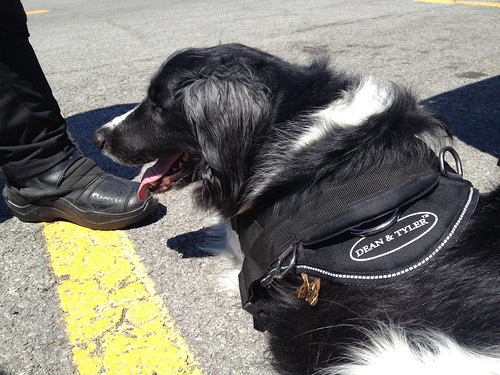
I’m undecided about our Dean and Tyler harnesses. They’re very well made, but Bandido kept putting an arm through his (aided by pulling against the end of the leash), and Ben seems to fall right between two sizes. On the other hand the clips on the side of the harnesses are something we only found on that brand, and was helpful in clipping the dogs into the tub in a way that allowed for minimal interference by the leash.
The Dean and Tyler wire muzzle we got for Bandido (after being advised on a size by one of their staff) seems to come right up to his eyes, and the straps never seemed to fall correctly across his head. We got the muzzle primarily to keep stupid people from trying to pet strangers dogs without asking. You’d think this would be obvious, especially with Ben barking people off, but it isn’t. They still try and pet him, and he really doesn’t want them to. The wire muzzle makes an excellent “Stay Away” sign. It should be noted that ‘Dido really doesn’t seem to mind it much even though he hates cloth muzzles. They have a couple basket-style leather ones that I’m pondering, but even if those solve the fit problem, they’re not as effective of a “Stay Away” sign. The reason we went with this one is that it’s big enough for ‘Dido to be able to open his mouth and pant on hot days. Some of the other muzzles wouldn’t enable panting, which we felt was a deal-breaker because it just wouldn’t be safe for him to wear it on hot days.
Conclusion
Taking an adventure with dogs, is probably a lot like taking an adventure with your kids; more work, but more fulfilling too. There’s something truly wonderful about traveling with them that I couldn’t have anticipated, and can’t put into words.
This trip was a hard one, and they came through it with flying colors. I truly believe that they’re going to love going around the world with us, as we’ll be able to take much more time to stop and pee on the roses.
